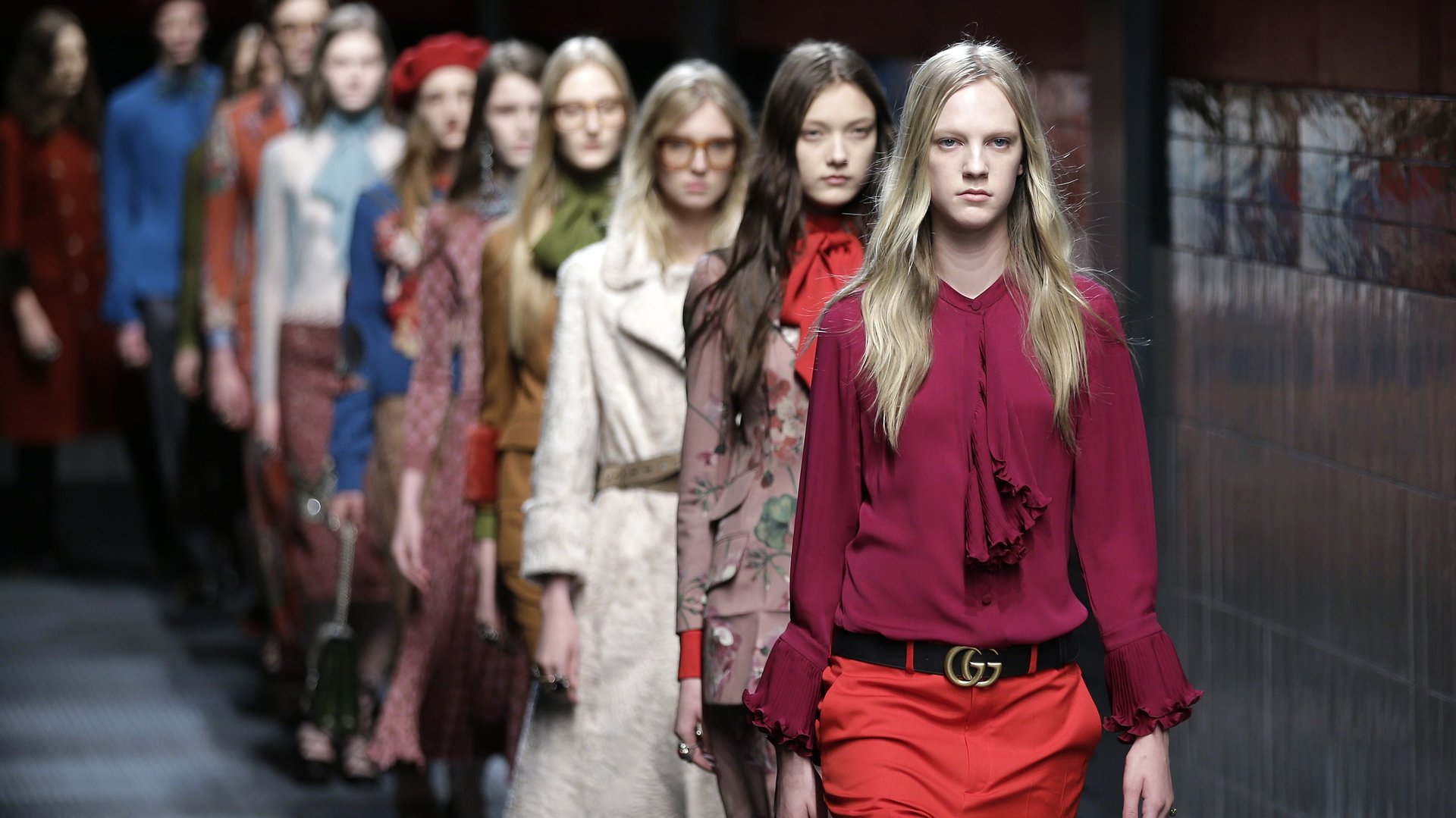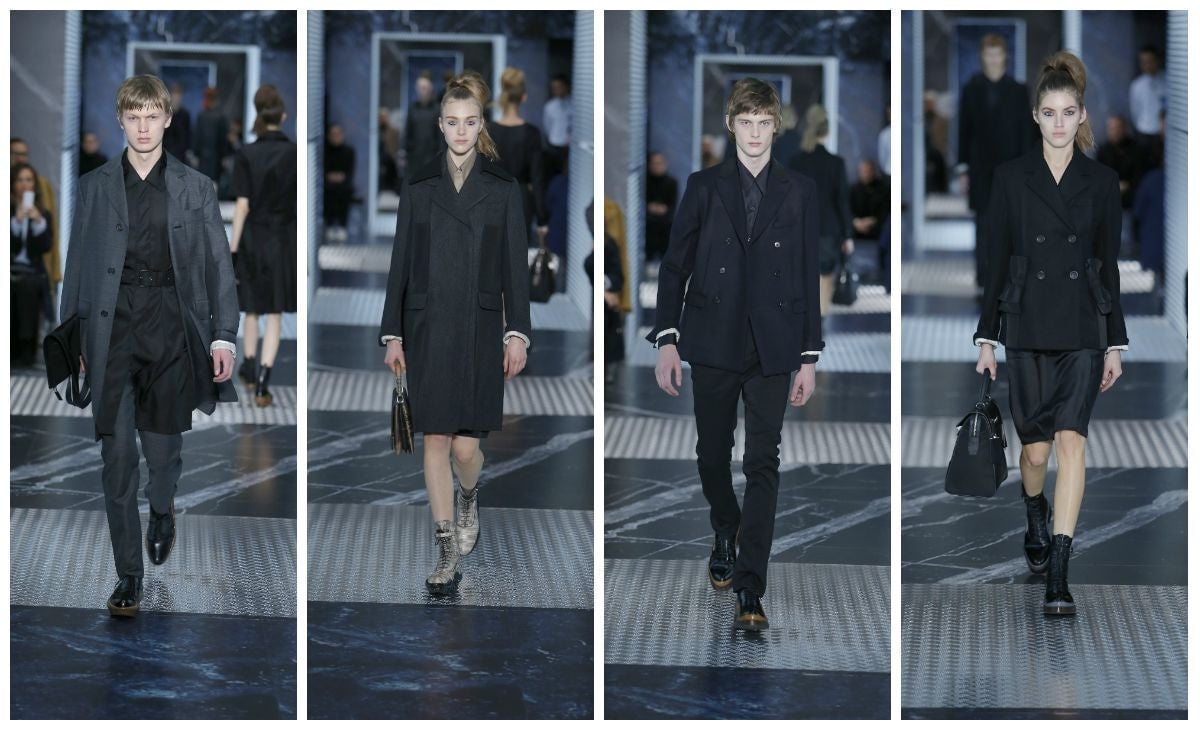Sex and gender aren’t perfectly binary. Why should clothes be?
One of fashion’s major story lines of the last year has been the industry’s sudden, widespread embrace of clothes that ignore gender lines. While cool, iconoclastic labels, such as Comme des Garçons, Rick Owens, and Rad Hourani, have been doing it for years, now Gucci is presenting pussy-bow blouses for guys, and Prada showed a collection last June that was simultaneously his and hers. The concept hasn’t been relegated to the runways either. Fancy London department store Selfridges unveiled its Agender campaign earlier this year, and come June, thecorner.com, an online boutique, will dedicate a channel on its site to what it calls “gender-neutral” clothing and accessories that offer ”an alternative to the classic ‘Men’s’ vs ‘Women’s’ dichotomy.”


One of fashion’s major story lines of the last year has been the industry’s sudden, widespread embrace of clothes that ignore gender lines. While cool, iconoclastic labels, such as Comme des Garçons, Rick Owens, and Rad Hourani, have been doing it for years, now Gucci is presenting pussy-bow blouses for guys, and Prada showed a collection last June that was simultaneously his and hers. The concept hasn’t been relegated to the runways either. Fancy London department store Selfridges unveiled its Agender campaign earlier this year, and come June, thecorner.com, an online boutique, will dedicate a channel on its site to what it calls “gender-neutral” clothing and accessories that offer ”an alternative to the classic ‘Men’s’ vs ‘Women’s’ dichotomy.”
The idea that humans are either male or female is deeply ingrained in Western culture, but as research and the experiences of countless non-gender-conforming people show, sex and gender aren’t perfectly binary. So, why should our clothes be? The rules that govern what men and women should wear are actually fairly arbitrary. We know that because they keep changing. In fact, men and women in Europe and other cultures wore more or less the same garments for centuries.
This new push for genderless dressing doesn’t seek to erase gender from clothing, just to loosen the constraints on what people should or shouldn’t wear.
Our bodies are not our selves
The fluidity of sex and gender is evident just from the fact that the two don’t always neatly align. While a person’s sex is usually assigned at birth based on physical and biological characteristics, gender refers to the way a person feels internally, as well as society’s expectations of how a person of a certain sex should act.
Plenty of people, however, don’t feel themselves to be the gender that matches the sex they were assigned—reality TV personality Bruce Jenner being a famous recent example. The exact number is difficult to determine, but it’s a common enough occurrence that cultures around the world recognize more than two genders and half of millennials believe that gender exists on a spectrum.
To blur the lines further, one in 100 people are born with some form of intersex anatomy. The standard definitions of female or male are narrow enough that back in 1993 the Brown University biology and gender studies professor Anne Fausto-Sterling proposed that five sexes exist, not two.
There’s some evidence that part of gender is built into our neurology during fetal development, but because it’s also a psychological and social construct, our environments also have a strong influence on how it’s shaped. These days, clothes play an important part in that process.

Dr. Jo Paoletti is a professor at the University of Maryland and the author of Pink and Blue: Telling the Boys From the Girls in America, which examines how children’s clothing became so heavily gendered in the 20th century. She says that, as children, we use clothing to play out different roles, including gender roles, with few restrictions. Girls, for instance, don’t necessarily dress up as princesses because they want to be royalty. The tiara and tutu—and all that pink—are in part about embodying an idea of femininity. The same girl might well dress in sneakers and jeans the next day, and a boy might enjoy trying out that same tiara and pink tutu.
“Clothing has this interesting property that we discover as kids—that you don’t have to just be something and you’re always that,” she says. “You can be a different thing—a different you—every day.”
We still perform in this sense as adults, non-transgender individuals included, when we dress in clothes we think look characteristically masculine or feminine. Just think of the tuxedo and wedding dress. And cross-dressing has long allowed people to explore and inhabit various parts of their personalities.
Clothes make the man, or woman
Clothing didn’t always carry such strong gender connotations. In her book Cut My Cote, author Dorothy Burnham examines that clothing was initially based on the shapes of the animal skins or fabrics it was fashioned from.
In ancient Rome, most of the design of a cloth garment took place on the loom, which meant everyone wore what were essentially long rectangles of draped fabric.
Those long rectangles eventually developed a hole for the wearer’s head and stitched sides, becoming a tunic. Both men and women wore them through the Middle Ages, and the differences between them were minimal: a woman’s tunic would reach her ankles, while a man’s would come to his knees. Perhaps the greatest distinction conferred by a person’s dress was social status, as reflected in sumptuary laws stating that only certain people could wear velvet, and that the lower classes were confined to drab wool or linen.
But gradually, sexual characteristics became more important in European clothes, partly on account of men’s incredible shrinking tunics. Slowly the bottom hem inched upward until the garment resembled a shirt, and as guys still weren’t wearing underwear at the time, this left a good deal of skin exposed between the tunic and the top of the woolen hose. A solution called the codpiece came along, and over time what originated as a functional way of covering a man’s anatomy developed into a public display of oversized, sometimes bejeweled, virility (with the added benefit of concealing syphilis bandages).
The dour Victorians took the distinction between men’s clothes and women’s still further. Before them, everyone with money wore equally elaborate, sumptuous, and colorful clothing. They put an end to that, as men’s dress abandoned rich fabrics and bold colors altogether. A businesslike sobriety took hold, emphasizing practicality, that only grew more pronounced in the Industrial era, when a man’s three-piece suit could be mass-manufactured.
The great differentiation between menswear and womenswear, at least in the West, was complete.

Trousers had become so associated with men that it was considered somewhat scandalous for women to wear them up through the early 20th century. When Amelia Bloomer popularized the pants that took her name, she did so as a statement about the role of women in society. Fashion reformers called it a means to “physically and spiritually free women of the cumbersome hoop [skirt].”
Those differences in dress came to symbolize the supposed differences in the sexes: Men, like a suit, were serious and practical; women, like a flouncy dress, were frivolous and superficial.
The Western version of the menswear-womenswear dichotomy also spread to other cultures. In Japan, men began wearing suits to work and reserved the kimono for use in the home; then wore it less and less until it became predominantly a woman’s garment. In Indonesia, the sarong worn by women and men started to vanish from everyday life as Westernized clothing replaced it. Colonialism basically dressed the world in the West’s image.
Back in the US, color started to take on the job of delineating gender among children. In the mid-19th century, blue and pink became popular colors for girls and boys, and by the early 20th century, society had decided that the genders belonged in separate shades—only, pink was considered by some more appropriate for boys, and blue was better for little girls. Trade publication Earnshaw’s Infants’ Department declared that “pink, being a more decided and stronger color, is more suitable for the boy, while blue, which is more delicate and dainty, is prettier for the girl.”
By the 1940s, the colors had switched genders, highlighting just how arbitrary the distinction is.
Clothing today, far from being superficial, remains a powerful and integral part of a person’s social and gender identity. That’s why wearing the ”wrong” gender’s clothes can be painful for those who don’t feel their sex and gender match—even very young children (video).
“This is a story I hear again and again and again,” says Jennifer Self, director of the Q Center at the University of Washington, an advocacy and mentoring center for queer students. “These folks have felt like they’ve been wearing costumes. They feel like they’ve been in drag.”
Unfinished business

In recent decades, gender-neutral clothing trends have cropped up from time to time, beginning with the rise of feminism and its questioning of gender roles. Dr. Paoletti views its latest resurgence as an extension of that conversation. She calls it “unfinished business from the 1970s.”
“There were a lot of questions raised by feminism, the Civil Rights movement, the gay rights movement about gender roles, and the extent to which individuals should follow gender roles,” she says. “And part of that is going to be the way you look.”
Since then, Self notes, ”As the gay and lesbian, bisexual, trans-movement has progressed, that has expanded into these notions of a non-binary understanding of gender.”
The designers creating gender-neutral clothes today echo the sentiments of those movements, consciously or not.
“I made an observation before starting Unisex to understand who I am as a person and how to express myself,” Rad Hourani told Vice. “I didn’t understand who decided that a man should be dressed differently than a woman and all of these other limitations that we have in life like our age, gender, religion, nation, or any other boundaries that divide people from each other.”
Prada’s fall-winter 2015 menswear show came with a manifesto declaring, “Gender is a context and context is often gendered.”

Of course, a handful of designers and retailers embracing gender-neutral clothing won’t resolve lingering questions about gender roles, and it’s debatable whether gender-neutral can ever be more than a niche market. The fact remains that we live in a very gendered society, and the bodies of men and women tend to have different shapes. To sell to the majority of customers, fashion labels have to design their clothes accordingly.
But if nothing else, this new space being carved out in the fashion world could create a slightly larger comfort zone for people who don’t feel—and don’t necessarily want to feel—like they fit in just one category. And that’s a good thing. We’re most comfortable in our clothes when they express how we feel, not hide it.